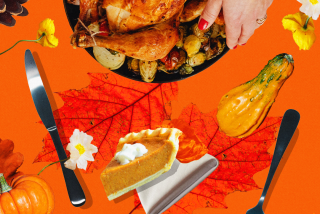What? No Buckles?
- Share via
Now, get this, pilgrim:
Sheldon Hall isn’t pulling your turkey leg when he says the first Thanksgiving was observed by Spanish conquistadors in El Paso 23 years before the pilgrims pigged out in Plymouth, Mass., in 1621. The Mother of All Feasts was not celebrated near a rock, but by a river called the Rio Grande.
Hall, a descendant of a Mayflower pilgrim and the director of El Paso’s Mission Trail Assn. (we don’t make this stuff up, folks), says there’s solid proof--documents in archives in Spain, Mexico and Texas.
According to Hall and several other historians, Don Juan de On~ate commemorated the first Thanksgiving with a banquet of ducks, geese and fish. His band of 400 men, 130 women and children in 83 carretas (or wagons) with 7,000 head of livestock, marched from Santa Barbara, Mexico, through the Chihuahuan Desert for four months before stopping at the Rio Grande on April 20, 1598.
They camped, swam in the river, and hunted and fished, according to a book by Gaspar Perez de Villagra Alcala, one of On~ate’s captains, in 1610.
Ten days later, On~ate ordered everyone to put on their best clothes and gather by a fire. He proclaimed the land for the King of Spain, followed by a feast of Thanksgiving and a religious play, also believed to be the first in America.
Wrote Villagra: “We built a great bonfire and roasted the meat and fish and then all sat down to a repast the like of which we had never enjoyed before.”
The next day, On~ate and his troops departed for their final destination, north of present-day Santa Fe.
Brooks Kelly, executive director of the Plymouth County Development Council, says many try to steal Plymouth’s Thanksgiving thunder.
“Some of us have had great fun with the controversy,” says Kelly of El Paso’s claim, one of several. Among the others: Juan Ponce de Leon’s landing in Florida in 1513, Francisco Vasquez de Coronado’s Eucharistic Thanksgiving in the Texas Panhandle in 1541, the landing of English settlers near what would become Jamestown, Va., in 1607 and, in the same year, another ceremony of thanks to God in Maine after a successful English voyage across the Atlantic Ocean.
“Some folks in Plymouth are deadly serious about the whole issue of not giving time to the claims of other Thanksgivings,” he says. But not Kelly, who believes that “history is something you should enjoy,” debates and all.
Peggy Baker, director-librarian of the Pilgrim Society and Pilgrim Hall Museum in Plymouth, agrees, adding: “The pilgrims are not the Hallmark Card image we think about.” Which is why--truth be told--she has no problem debunking myths and fabrications regarding pilgrims.
Which reminds us of fabric, so let’s begin there.
* For starters, pilgrims didn’t wear black. Those mournful, somber costumes kids wear in school plays were too rich for their blood. “Black fabric was extremely expensive--only the wealthy wore it,” Baker says. Walking off the Mayflower on Dec. 21, 1620, the pilgrims put on quite a colorful show--trousers, shirts and dresses in maroons, greens and blues. For men, bright red and purple vests were quite the rage.
* Nor did they wear buckles on their hats. In the late 17th century, buckles on hats were in vogue for judges at the Salem witch trials, but not in the days of pilgrim colonization. Later artists “were trying to give the pilgrims the impression of antiquity and this is one of those misconceptions,” Baker says.
* You can also blame artists for painting breastplates on pilgrims, probably to give the impression that they needed protection from Native Americans as they disembarked from the Mayflower. Native Americans--many of whom spoke English--were friendly because they had become accustomed to other explorers, Baker says, which takes us to the next myth.
* Pilgrims were not the first to land in the Plymouth vicinity. “There already had been French, English and Portuguese explorers and commercial fishing fleets in the area,” Baker says. “We have a beautiful map of Plymouth Beach drawn in 1605. This wasn’t strange territory.”
* The pilgrims didn’t meet Native Americans when they pulled into Plymouth Rock as paintings portray. “Never happened,” Baker says. “They met their first Native American, Samoset, three months after they arrived. He walked into the settlement and said, ‘Welcome, Englishmen.’ He was from Maine.”
* The pilgrims didn’t even own the Mayflower. They rented the aging 90-foot ship and the services of its captain and owner, Christopher Jones. Four months later Jones sailed the ship back to England. He died a couple of years later and the Mayflower was sold bit by bit for lumber and spare parts.
* Geese and venison were more likely to have been on the menu than turkey at the harvest feast shared with 90 Native Americans.
* To the dismay--and shock--of tourists, Plymouth Rock is not the Rock of Gibraltar. Baker says of the 5-foot-long, 2-foot-tall rock: “It is small, disappointing and only a rock. But it is certainly the only good-sized rock on Plymouth Harbor.”
Today, the rock is one-third its original size because in 1776 some patriots split it in half and dragged it to the town’s “liberty tree.” Later the rock was again dragged a third of a mile to the front of Pilgrim Hall Museum. The rock was hauled back to the wharf in 1880, where it was cemented together (the crack is noticeable). In 1920 the wharf was torn down and a new portico was erected around the rock.
“That rock was dragged around so much that pieces of it were knocked off,” Baker says. “Bits of it are in town halls here and there.”
More to Read
Sign up for The Wild
We’ll help you find the best places to hike, bike and run, as well as the perfect silent spots for meditation and yoga.
You may occasionally receive promotional content from the Los Angeles Times.






